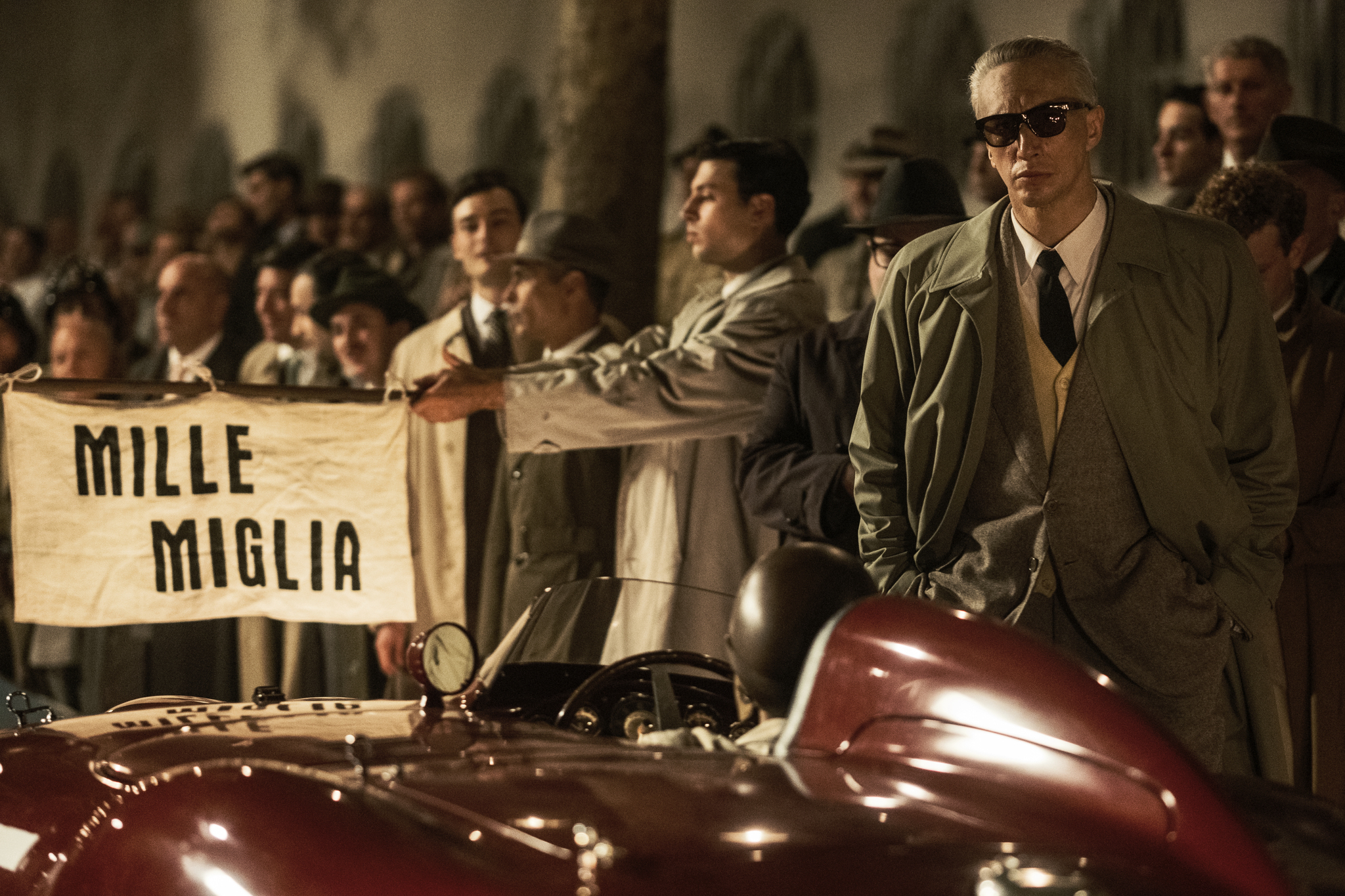Michael Mann’s Ferrari, out Dec. 25, is unsparing in its portrayal of the double life led by the famed race car driver and automotive entrepreneur.
As the biopic shows, Enzo Ferrari (Adam Driver) was married to Laura Garello (Penélope Cruz) for 54 years—until her death in 1978—but their marriage was far from a fairytale partnership. Set in 1957, as Ferrari is leading the motorsports industry, the movie traces how Enzo and Laura’s relationship deteriorates after the death of their 24-year-old son, Dino. The film also details Enzo’s affair with Lina Lardi (Shailene Woodley), with whom he had a son, Piero, who would become the next heir to the Ferrari fortune.
By ending Ferrari with the deadly crash at the 1957 Mille Miglia, the film suggests that Ferarri’s obsession with race car driving came at the expense of his drivers. Here’s the story behind the film.
Who was Enzo Ferrari?
The film takes place in 1957, when Ferrari the motorsports entrepreneur is reeling with grief after the death of his son in 1956, and the company’s race cars are preparing for the Mille Miglia, the premier road race of the time.
Race car driving was especially dangerous in that era because it took place on open roads, and drivers and spectators were routinely killed at these events. The film ends with the 1957 Mille Miglia, where, as shown in the film, a Ferrari car driven by Alfonso de Portago swerved into onlookers, leaving 12 people dead, including five children. The tragedy marked the end of the era of open road racing.
Behind Enzo Ferrari’s complicated love life
Ferrari and Laura Garello first met in Turin. They lived together for two years, and got married on April 28, 1923. But there wasn’t much of a honeymoon period, according to the Brock Yates, whose 1991 book Enzo Ferrari: The Man and the Machine inspired Mann’s film.
In one passage, Yates writes of their relationship, "That Ferrari’s marriage was to descend quickly into a legal arrangement is an understatement. While numerous photographs exist of him and his new wife at various races in the early 1920s, he soon became the traditional Italian husband, seeking sexual conquests not so much for pleasure but for simple gratification of the ego. Enzo Ferrari was to remain obsessed with sex for most of his life, and it was probably within months that his marriage vows to Laura were shattered. Years later he was to remark to Romolo Tavoni, a veteran racing manager and close personal associate, that “a man should always have two wives.”
Yates, now deceased, writes that Ferrari got married as a career move, to keep up appearances. Divorce was also frowned upon in predominantly Catholic Italy. But, Yates writes, he was ruthless in his pursuit of “sexual conquests,” always involved with a range of “flashy, often trashy women.” He was also known for being crude at dinner meetings—scratching his crotch and belching loudly. As Ferrari once wrote in 1961, when he was dating three women at once, “I am convinced that when a man tells a woman he loves her, he only means that he desires her and that the only perfect love in this world is that of a father for his son.”

Indeed, that comment came five years after the death of his son Dino. What kept Enzo and Laura together was their love for their frail son. Though Dino suffered from chronic health issues and kept a low profile, he was seen around the factory from time to time. He never raced because of his health, but his father provided him with a fleet of cars that he drove around for fun. Ferrari credited his son with designing car engine parts while he was bedridden.
“His real loves in life were racing and Dino,” says John Nikas, writer and expert on the history of cars who founded the British Sports Car Hall of Fame.
Following Dino’s death in 1956 of mysterious illness, Laura became much more involved in the Ferrari company’s operations in Modena, “often prowling the floor and making life difficult for the staff,” as Nikas puts it. Ferrari threw himself into racing cars, as emotionally distant with his drivers as he was with the women he chased. “Ferrari’s only interest was winning. He really didn't care about the drivers,” Nikas says.
Throughout the racing and marriage drama, Yates writes, Ferrari sought refuge in one woman in particular. Ferrari met Lina Lardi around 1944 when he was 46, and she was working in a Ferrari factories during World War II. When she gave birth to their son, Piero, on May 22, 1945, Ferrari secretly visited her at her home in her native Castelvetro. Ferrari depicts several of these visits, including one where Ferrari takes Piero to see his half-brother Dino’s grave.

The existence of Piero Lardi was largely kept secret, according to Yates. Only a few of Ferrari’s confidantes knew about him. “There is no question that at some point in the late 1950s, Laura Ferrari discovered her husband’s second life,” Yates writes in his biography, adding whenever Laura saw Piero in a factory, she would shout “Bastard!” In 1963, it was reported that Piero was about to go into his father’s office one day but saw Laura and ran off before she recognized him. In the movie, there are several tense exchanges between Ferrari and Laura where she accuses him of replacing Dino with Piero.
Ferrari adopted Piero formally after Laura’s death in 1978, and he took on the name Piero Lardi Ferrari. He’s currently the billionaire vice chairman of the company. And he told the Los Angeles Times that what happens in the film is “really what happened,” especially the way it captures his father’s drive, explaining, “My father was a person who was always looking ahead, moving forward, never going back.”
More Must-Reads from TIME
- Caitlin Clark Is TIME's 2024 Athlete of the Year
- Where Trump 2.0 Will Differ From 1.0
- Is Intermittent Fasting Good or Bad for You?
- The 100 Must-Read Books of 2024
- Column: If Optimism Feels Ridiculous Now, Try Hope
- The Future of Climate Action Is Trade Policy
- FX’s Say Nothing Is the Must-Watch Political Thriller of 2024
- Merle Bombardieri Is Helping People Make the Baby Decision
Write to Olivia B. Waxman at olivia.waxman@time.com